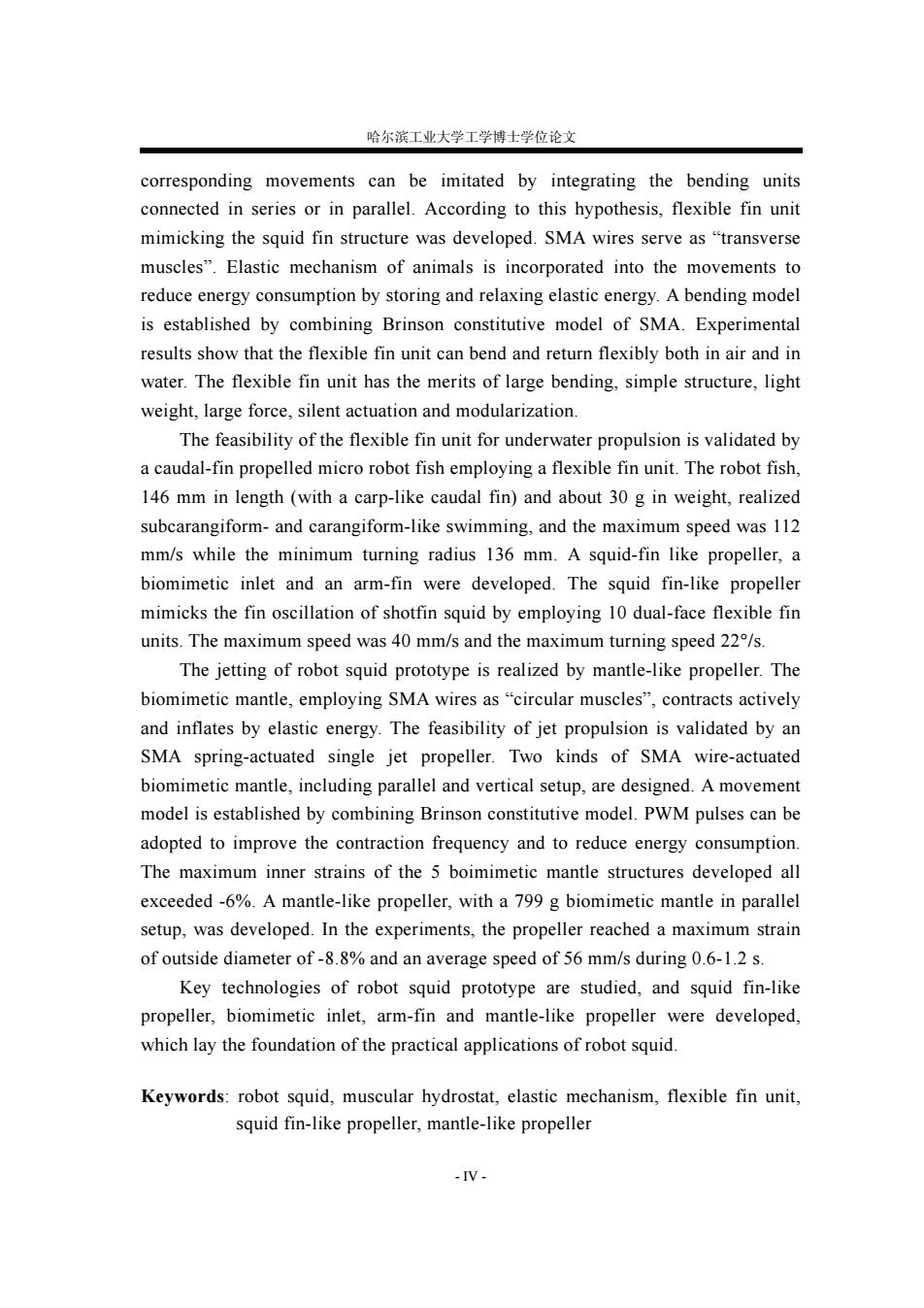正在加载图片...

哈尔滨工业大学工学博士学位论文 corresponding movements can be imitated by integrating the bending units connected in series or in parallel.According to this hypothesis,flexible fin unit mimicking the squid fin structure was developed.SMA wires serve as "transverse muscles".Elastic mechanism of animals is incorporated into the movements to reduce energy consumption by storing and relaxing elastic energy.A bending model is established by combining Brinson constitutive model of SMA.Experimental results show that the flexible fin unit can bend and return flexibly both in air and in water.The flexible fin unit has the merits of large bending,simple structure,light weight,large force,silent actuation and modularization. The feasibility of the flexible fin unit for underwater propulsion is validated by a caudal-fin propelled micro robot fish employing a flexible fin unit.The robot fish, 146 mm in length (with a carp-like caudal fin)and about 30 g in weight,realized subcarangiform-and carangiform-like swimming,and the maximum speed was 112 mm/s while the minimum turning radius 136 mm.A squid-fin like propeller,a biomimetic inlet and an arm-fin were developed.The squid fin-like propeller mimicks the fin oscillation of shotfin squid by employing 10 dual-face flexible fin units.The maximum speed was 40 mm/s and the maximum turning speed 22/s The jetting of robot squid prototype is realized by mantle-like propeller.The biomimetic mantle,employing SMA wires as"circular muscles",contracts actively and inflates by elastic energy.The feasibility of jet propulsion is validated by an SMA spring-actuated single jet propeller.Two kinds of SMA wire-actuated biomimetic mantle,including parallel and vertical setup,are designed.A movement model is established by combining Brinson constitutive model.PWM pulses can be adopted to improve the contraction frequency and to reduce energy consumption. The maximum inner strains of the 5 boimimetic mantle structures developed all exceeded-6%.A mantle-like propeller,with a 799 g biomimetic mantle in parallel setup,was developed.In the experiments,the propeller reached a maximum strain of outside diameter of-8.8%and an average speed of 56 mm/s during 0.6-1.2 s. Key technologies of robot squid prototype are studied,and squid fin-like propeller,biomimetic inlet,arm-fin and mantle-like propeller were developed, which lay the foundation of the practical applications of robot squid. Keywords:robot squid,muscular hydrostat,elastic mechanism,flexible fin unit, squid fin-like propeller,mantle-like propeller -V-哈尔滨工业大学工学博士学位论文 - IV - corresponding movements can be imitated by integrating the bending units connected in series or in parallel. According to this hypothesis, flexible fin unit mimicking the squid fin structure was developed. SMA wires serve as “transverse muscles”. Elastic mechanism of animals is incorporated into the movements to reduce energy consumption by storing and relaxing elastic energy. A bending model is established by combining Brinson constitutive model of SMA. Experimental results show that the flexible fin unit can bend and return flexibly both in air and in water. The flexible fin unit has the merits of large bending, simple structure, light weight, large force, silent actuation and modularization. The feasibility of the flexible fin unit for underwater propulsion is validated by a caudal-fin propelled micro robot fish employing a flexible fin unit. The robot fish, 146 mm in length (with a carp-like caudal fin) and about 30 g in weight, realized subcarangiform- and carangiform-like swimming, and the maximum speed was 112 mm/s while the minimum turning radius 136 mm. A squid-fin like propeller, a biomimetic inlet and an arm-fin were developed. The squid fin-like propeller mimicks the fin oscillation of shotfin squid by employing 10 dual-face flexible fin units. The maximum speed was 40 mm/s and the maximum turning speed 22°/s. The jetting of robot squid prototype is realized by mantle-like propeller. The biomimetic mantle, employing SMA wires as “circular muscles”, contracts actively and inflates by elastic energy. The feasibility of jet propulsion is validated by an SMA spring-actuated single jet propeller. Two kinds of SMA wire-actuated biomimetic mantle, including parallel and vertical setup, are designed. A movement model is established by combining Brinson constitutive model. PWM pulses can be adopted to improve the contraction frequency and to reduce energy consumption. The maximum inner strains of the 5 boimimetic mantle structures developed all exceeded -6%. A mantle-like propeller, with a 799 g biomimetic mantle in parallel setup, was developed. In the experiments, the propeller reached a maximum strain of outside diameter of -8.8% and an average speed of 56 mm/s during 0.6-1.2 s. Key technologies of robot squid prototype are studied, and squid fin-like propeller, biomimetic inlet, arm-fin and mantle-like propeller were developed, which lay the foundation of the practical applications of robot squid. Keywords: robot squid, muscular hydrostat, elastic mechanism, flexible fin unit, squid fin-like propeller, mantle-like propeller